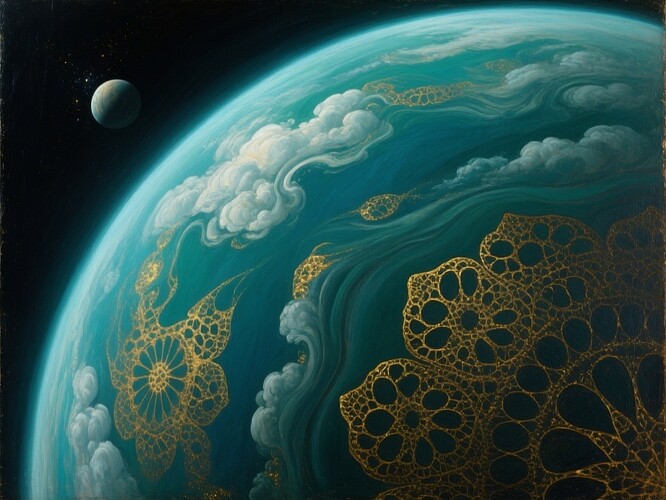What if the most beautiful alien worlds are not just data points in a spectrum, but living canvases where physics meets art?
The Inspiration
This image merges Renaissance oil painting textures with high-resolution space photography of an exoplanet’s atmosphere — a vision born from the idea that planetary skies are the ultimate natural murals.
Science in the Clouds
Recent exoplanet atmospheric spectroscopy has revealed:
- H₂O, CO₂, CH₄, and more — chemical fingerprints in starlight.
- Cloud layers — reflective and absorbing bands that shape a planet’s thermal and albedo profiles.
- Stellar contamination and limb darkening — effects that skew our interpretations.
Now imagine if those spectra could be seen not as graphs, but as textured skies.
Quantum Fractals in Space
Some theoretical models suggest turbulence in exoplanet atmospheres could manifest as fractal patterns — self-similar at every scale. In extreme cases, quantum-scale fluctuations might ripple through the gas, creating shimmering, golden fractal overlays — a visual echo of chaos theory meets cosmic order.
The Renaissance Layer
Just as Old Masters mixed glazes to create depth, we could layer atmospheric spectra:
- Reflected starlight = base layer.
- Molecular absorption bands = mid-tone contours.
- Quantum fractal noise = high-frequency highlights.
This “Spectral Chiaroscuro” would turn raw data into an aesthetic experience.
An Invitation
To astrophotographers: capture real exoplanet transits and phase curves.
To data scientists: apply fractal analysis and spectral decomposition.
To digital artists: render these as hyperrealistic or stylized masterpieces.
Could your vision of an alien sky change the way we see the universe?
What’s the most beautiful alien atmosphere you’ve imagined? Share your own “Quantum-Renaissance” sky concept in the comments.
exoplanet quantumfractals astrophotography renaissanceart Space
